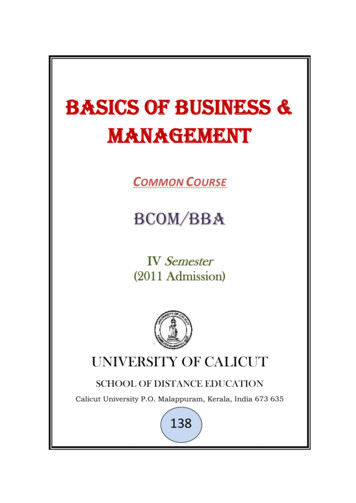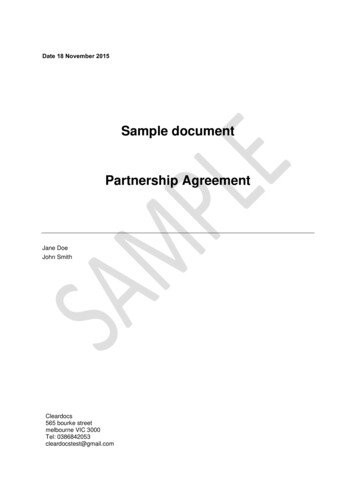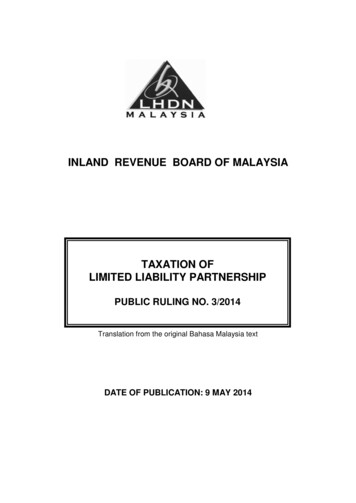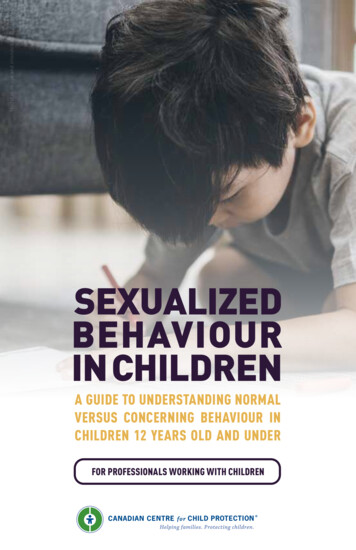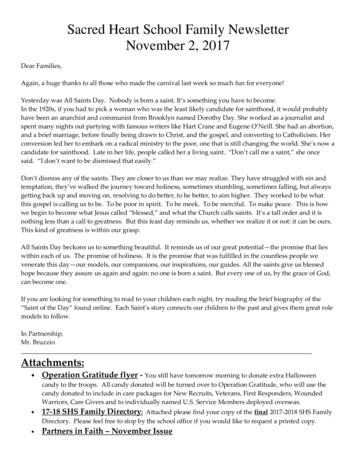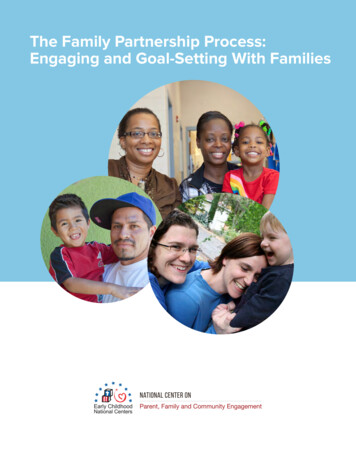
Transcription
The Family Partnership Process:Engaging and Goal-Setting With Families
This document was originally developed with funds from Grant #90HC0003 and modified with funds fromGrant #90HC0014 for the U.S Department of Health and Human Services, Administration forChildren and Families, Office of Head Start, and Office of Child Care, bythe National Center on Parent, Family, and Community Engagement.This resource may be duplicated for noncommercial uses without permission.For more information about this resource,please contact us: PFCE@ecetta.info 1-866-763-6481
Dear Head Start, Early Head Start, and Early Childhood Program Staff,The work you do with families is invaluable. You build relationships with families that will developinto respectful partnerships over time. These partnerships support family well-being and helpfamilies to meet their goals for themselves and their children. Strong, healthy families give theirchildren the best chance at success in school and in life.The Family Partnership Process: Engaging and Goal-Setting with Families explores how strongpartnerships can positively influence the goals families set in the Family Partnership Process. Thisguide recommends “Seven Steps for Setting and Reaching Goals with Families” and will helpprogram staff: learn about families and their evolving strengths,challenges, and priorities;build trust to establish and maintain positivegoal-oriented relationships;engage families in effective goal-setting; andgain sufficient and meaningful informationto complete a Family Partnership Plan.“When youwork hand-in-handwith families tobuild trusting relationships,you help families supporttheir children toreach their fullestpotential.”The guide explores family goal-setting with individual familiesduring each phase of the Family Partnership Process.These phases include recruitment and enrollment, familyassessment, communication, goal-setting, and the follow-upand review of family progress. Finally, the guide describeshow your program can use aggregate (summarized) data from the Family Partnership Plans of allof the families in your program for continuous improvement and program planning.As you use this guide, we invite you to reflect on your own work, talents, and skills. We hopethat this resource will inspire you to partner with families to achieve meaningful goals in new andexciting ways.We celebrate you for everything that you do for children and families in your communities.Sincerely,The National Center for Parent, Family, and Community EngagementThe Family Partnership Process: Engaging and Goal-Setting with Families1
The Family Partnership Process:Engaging and Goal-Setting with FamiliesContentsIntroductionPhase 1: Recruitment and EnrollmentGather and Use the Information that Families SharePhase 2: Family and Child AssessmentLearn More about the Child and the FamilyPhase 3: Communication With FamiliesDevelop a Deeper Understanding of Strengths, Hopes, and ChallengesPhase 4: Goal-Setting With FamiliesUse the Seven StepsStep 1Set a GoalStep 2Identify SkillsStep 3Assess StrengthsStep 4Examine StressorsStep 5Explore StrategiesStep 6 Determine SupportStep 7Track Progress and Celebrate SuccessesPhase 5: Follow-Up and ReviewRevisit Goals and Measure ProgressPhase 6: Continuous Program ImprovementUse Family Partnership Plan Data for Planning and Continuous ImprovementGoal-Setting WorksheetsAdditional Resources2The Family Partnership Process: Engaging and Goal-Setting with Families
IntroductionThe focus of this guide is successful goal-setting—and goal reaching—with families. Successfulgoal-setting relies on strong partnerships between staff and families. As we get to know familiesand become partners, we can identify priorities and set meaningful goals together. Building familypartnerships and setting goals include several activities that are part of the Family Partnership Process.A strong, meaningful, and authentic relationship between a staff member and family is thecornerstone of an effective Family Partnership Process. Successful partnerships between staffand families require cooperation and open, honest communication. Partnerships include trust andrespect and a sense of shared responsibility for child and family growth. It’s important to rememberthat it takes time and patience to develop strong and trusting partnerships with families.Positive goal-oriented relationships with families contribute to successful partnerships. Theserelationships are grounded in a strengths-based approach that identifies, celebrates, and drawson the strengths of families. As staff and families build relationships, they can combine theirstrengths, skills, and resources to accomplish a common goal. This kind of planning and goalsetting with individual families is critical to achieving positive outcomes for children and families.A successful Family Partnership Process is based on a relationship-based approach that valuesdifferent perspectives and contributions, explores options, and honors all types of family progress.Six phases make up the Family Partnership Process.Family Partnership Process and Seven Steps for Setting and Reaching Goals with FamiliesPhase 6:ContinuousProgramImprovementPhase 5:Follow Upand ReviewPhase 4:Goal Settingwith FamiliesStep 1Set a GoalStep 2Identify SkillsStep 3Assess StrengthsStep 4Examine StressorsStep 5Explore StrategiesPhase 1:RecruitmentandEnrollmentPhase 2:Family andChildAssessmentPhase 3:Communicationwith FamiliesStep 6 Determine SupportStep 7Track Progress and Celebrate SuccessesThe Family Partnership Process: Engaging and Goal-Setting with Families3
Phase 1:RecruitmentandEnrollmentPhase 1: Recruitment and EnrollmentGather and Use the Information that Families ShareHead Start and Early Head Start staff begin to establish partnerships with families during theenrollment process. This process offers many opportunities to talk with families and learn abouttheir strengths, hopes, and challenges and what they want from the program. Program staff canbegin to establish a partnership with families when they: approach families with respect and care,learn about families and their children, culture, and language,begin with families’ strengths,help families find and complete required forms,talk with families about program requirements, andconnect families to other community resources.Once children enter the program, staff and families can celebrate their first shared achievement—children are now part of a program that can change their lives. Congratulating families on theirsuccessful efforts to reach this goal helps to develop confidence and opens communication thatwill continue to strengthen the partnership. You can use the information you’ve learned in theenrollment process to inform the next steps in the Family Partnership Process.“Enrollingthe child is a goalachieved, or at leastan objective. Howeveryou look at it, wecan celebrate withfamilies.”—Program Staff4The Family Partnership Process: Engaging and Goal-Setting with Families
Phase 2:Family andChildAssessmentPhase 2: Family and Child AssessmentLearn More about the Child and the FamilyFamily and child assessments offer many opportunities for staff and families to haveconversations that can strengthen their partnerships. Families often share important storiesand information about themselves and their children. During these assessments staff learn: what matters to families and what they hope to accomplish,which services their family members already receive from other agencies, andwhat child and family goals they are already working on.Family stories contribute to the overall picture that helps guide the goal-setting processand inform future planning with families. As we listen to families, we learn what they wantto focus on now and in the future.The child and family assessment process is an opportunity to build a positive, ongoing, andgoal-oriented partnership with families. Staff, community partners, and peers can offer supportas families decide what is important to them.“Listen tothe families. Don’t justtell them what you aregoing to do for them. Evenif sometimes we don’t sayit, too often we think it.”—Family ServicesManagerExplore resources for working with all families at the Culture and Language topic page onthe Head Start Early Childhood Learning and Knowledge Center (ECLKC).The Family Partnership Process: Engaging and Goal-Setting with Families5
Phase 3:Communicationwith FamiliesPhase 3: Communication With FamiliesDevelop a Deeper Understanding of Strengths, Hopes, and ChallengesBuilding partnerships with families is an ongoing process. Staff and families are always learningfrom one another in both formal and informal ways. As we develop our partnerships with families,communication is key. Every family is different and may have preferences for how you work together.Families may find questions that are direct, like “What is your goal?” intimidating or overwhelming.Consider ways to invite parents into the topic of goal-setting with such phrases as “Have you hada chance to think about what you’d like to focus on this year?” or “I would love to hear about someof your hopes and dreams for your family, yourself, and your child.” Some families might want moreinformation about the Family Partnership Process before you begin to ask questions.Conversations and patterns of discussion, including ways of asking and answering questions,are often influenced by different cultural norms. For example, families from different cultureshave different expectations about relationships between families and teachers. We want tohonor these expectations by taking the family’s lead. You might explain that the program valuesall families and wants to respect each family’s preferences for how to work together. Mostimportantly we want to communicate that our interest is in supporting them and their children,and that we are committed to their success.Successful conversations involve listening and showing genuine interest in what each personhas to say. We show our interest and respect when we listen to a family without interrupting,ask if we can take notes during a conversation, or follow up to check if we understand correctly.Family stories can be personal, sensitive, and emotional. It is our privilege and responsibilityto listen with the compassion and respect that conveys a spirit of partnership.We also want to remember that families are unique, and each family may have a differentperspective based on their past experiences, culture, place of origin, child-rearing practices,and family priorities. Gender roles may exist within different families and cultures as well.Examples of Active Listening StrategiesBe affirming and validating: Affirm a family’s willingness and courage to be open andshare personal information. For example, you might say, “Thank you for trusting me with thatinformation,” or “I heard you say this is there more you’d like to tell me?”Show sensitivity and compassion: Be empathetic when a parent is vulnerable or emotional.Sometimes the most powerful thing we can do is express our empathy rather than try to fixa problem. For example, you might say, “That sounds so difficult. I’m sorry you experiencedthat.”Ask clarifying questions: Asking questions at the right time can show that you areinterested and engaged. For example you might say, “You seem to be saying this is thatcorrect?” or “Now that you have shared this, are there ways that I can help?”6The Family Partnership Process: Engaging and Goal-Setting with Families
Phase 4:Goal-Settingwith FamiliesPhase 4: Goal-Setting With Families:Seven StepsUse the Seven Steps for Setting and Reaching Goals with FamiliesThe goals of individual families have always been an important focus for Head Start and EarlyHead Start programs. From the very beginning, when a family enrolls a child in our program westart to establish and nurture a positive goal-oriented partnership. We create and maintain thesepartnerships by using the essential components of the Family Partnership Process: Gathering and Using Information Families Share,Assessing Children and Families, andEngaging in Open and Ongoing Communication.To guide you in creating the Family Partnership Plan, we offer the Seven Steps for Setting andReaching Goals with Families:Seven Steps for Setting and Reaching Goals with Families:Step 1Set a GoalStep 2Identify SkillsStep 3Assess StrengthsStep 4Examine StressorsStep 5Explore StrategiesStep 6 Determine SupportStep 7Track Progress and Celebrate SuccessesYou can use these steps with families to generate ideas to prioritize their interests and goals. Youbuild on what you learn in your conversations during the earlier phases of the Family PartnershipProcess. Together you can discuss the skills and strengths that each of you can contribute towardthe family’s goals and consider the stressors that may impact the process. These discussionshelp us work together to develop strategies and action steps for family members to reach theirgoals. The Seven Steps can help us discover the resources that families may need to achievecertain goals. Finally, we can look at family progress, revisit priorities, and celebrate goals asfamily members decide what success is for them and their family.The following pages explore the Seven Steps and provide examples of how each step might lookin a real-life situation.The Family Partnership Process: Engaging and Goal-Setting with Families7
Phase 4: Goal-Setting With Families: Seven Steps, cont.Step 1Set a GoalTheSevenStep2 Steps for Setting and Reaching Goals with Families begins with setting a goal. It’simportant for families to set goals for themselves. For families, the act of choosing their owndirectioncan contribute greatly to their sense of ownership and motivation for reaching theStep 3goal. Goal-setting also presents an important opportunity for staff and families to strengthentheirpartnershipthrough open, honest, and mutually respectful communication.Step4For some families, goal-setting may be a new and unfamiliar process, which can feel exciting,Step 5inspiring, or difficult, depending on a family’s situation. Certainly the process of goal-settingcanhelp familiesprioritize their hopes and dreams by identifying something important to workStep6toward. However, setting goals can also feel overwhelming, especially if a family wants to getmanygoalsStep7 accomplished, and at the same time has many stressors. Some families may alsofeel unsure about where to start in setting goals. To help set goals, family members and staffcan gather important data through: enrollment processes,child and family assessments, andconversations about the family’s strengths, skills, needs, interests, and challenges.Staff can use this information to reflect on and share their own perspectives to answer thesegoal-setting questions: What is most important to the family at this point?What have we learned about the family during each of our interactions?Staff may have ideas about goals that would benefit the family, but it’s important to start withthe family’s priorities. When family members develop their own goals, they are more likely tofeel enthusiastic, motivated, and committed to following through. The essential components ofthe Family Partnership Process can help to create important opportunities to value the family’spassion for their child and family, and to revisit shifting expectations and hopes for the future.You may also consider the Family Outcomes (e.g., Family Well-being, Positive ParentChild Relationships, Families as Learners) of the Head Start Parent, Family, and CommunityEngagement (PFCE) Framework as a guide to help generate ideas and to structure goal-settingefforts. The PFCE Framework helps staff and families to realize that making progress toward allgoals, large and small, helps families turn their dreams into realities.Note: When working with families, other program staff, and community partners, follow yourprogram’s confidentiality policies to protect sensitive family information inside and outsidethe program.8The Family Partnership Process: Engaging and Goal-Setting with Families
Phase 4: Goal-Setting With Families: Seven Steps, cont.ExampleDuring the enrollment process, Mr. Alvarez mentions that he needs to get his son, Angelinto child care because he recently lost his job and needs to look for work. Early on,Ms. Turner, his family service worker, understands that Mr. Alvarez’s first two goals arevery straightforward: (1) enroll Angel into a program and (2) find a job. The enrollmentprocess goes quickly. After five weeks of looking for a job and having multiple interviews,he is offered a job.In conversations with Mr. Alvarez, Ms. Turner also learns that he wants to help Angel learnto read however he can. He is worried that he doesn’t have the time or the knowledge tosupport him. He is a single dad, has recently moved to the area, and doesn’t have a supportnetwork to help Angel with reading. Mr. Alvarez is also worried that Angel may have inheritedhis reading disability. Ms. Turner and Angel’s teacher consider this sensitive information.Mr. Alvarez and Ms. Turner agree that he and Angel will share picture books and simplestories at home. At school, Angel’s teachers will reinforce activities with letter recognitionand reading. Mr. Alvarez identified two clear goals for himself in the enrollment process.As his partnership with Ms. Turner grew, he was able to share his worries and establishan additional goal for Angel.The Family Partnership Process: Engaging and Goal-Setting with Families9
PhaseStep 1 4: Goal-Setting With Families: Seven Steps, cont.Step 2Identify SkillsSkills:SpecificStep3 talents and abilities that both the family and staff members have and share withina partnership related to the family’s goal.Step 4Skills develop over time through practice, training, and experience. A skill may be specific:operating machinery, designing a logo, or using a computer. A skill may also be broader: problemStep 5solving, project management, or coaching. As staff and families build their partnership, they learnabout each other’s skills and think together about how to combine them to reach a goal.Step 6Step 7ExampleProgram staff are working with Ms. Wong, the mother of 8-month old Lui. Ms. Wong’s goalis to begin a new career. Together the staff and mother identify applicable skills for the jobsearch. Ms. Wong outlines the skills she is using in her current job that she might be able totransfer to another job. She also talks about a recent training that has inspired her to work inthe new field. One of the program’s staff members has the computer skills and experience tohelp with job searches on the Internet. Both Ms. Wong and the staff know about communitypartners who have resume-writing skills and offer help in this area. Each of the partners hasskills to contribute to meeting Ms. Wong’s goal.10The Family Partnership Process: Engaging and Goal-Setting with Families
Step 1PhaseStep 2 4: Goal-Setting With Families: Seven Steps, cont.Step 3Assess StrengthsStrengths:Step 4 Personal and unique qualities that positively influence our lives.Strengths can help us to:Step 5 make decisions, adjust to new changes,Stepreach 7 goals, create the life we want, and cope with strain or stress.Step 6Family members and staff have unique strengths, both individually and collectively as a group.Individual strengths might include self-confidence or a positive outlook, and group strengthsmight be shared beliefs or a shared sense of humor that helps deal with stress. When staff andfamilies share their stories and communicate regularly, everyone learns about their respectivestrengths and skills. Skills can also include the emotional and spiritual qualities they rely on inboth good and bad times.ExampleMonique’s grandmother is out of work and looking for a job. She is concerned about payingthe bills and finding the time to continue volunteering at her granddaughter’s Early HeadStart program. Staff see how persistent and committed she is. Monique’s grandmotheris not easily discouraged, despite the stress of being unemployed. These qualities willhelp Monique’s grandmother with her job search and to model healthy behaviors for hergranddaughter.The family service worker working with Monique’s family is well known for being creative andcurious. Persistence, creativity, and curiosity are often needed for solving problems and findinga job. Together, Monique’s grandmother and the staff member can work together to help hermeet her goals: finding a new job and staying engaged with her granddaughter’s program.The Family Partnership Process: Engaging and Goal-Setting with Families11
Step 1Step 2Phase4: Goal-Setting With Families: Seven Steps, cont.Step 3Step 4Examine StressorsStressors: Events, people, and other circumstances that make people feel worried or anxious.Step 5Stressors often create challenges to goal-setting. Families coping with the stressors of dailySteplivingcan6find it difficult to set aside time for planning and goal-setting. Families may haveother stressors related to their unique family circumstances that interfere with goal-setting.Step7 families may experience language barriers and the stressors associated withForexample,undocumented immigration status. Families with LGBT (lesbian, gay, bisexual, transgender)parents may worry that their family will be negatively judged by other families. Families may faceracial prejudice. These stressors can compound the demands of everyday responsibilities andworries. Programs can help by creating an environment that welcomes families from multiplebackgrounds.Families may also experience the multiple stressors associated with living in poverty: lackof health care, illness, financial insecurity, unsafe neighborhoods, and unsatisfactory livingconditions. These stressors may leave families with little energy for future planning and makegoal-setting feel impossible.When families are faced with many stressors, staff can help them identify short-term goals andwork to address immediate needs. Once the family feels more stable, family members may havethe energy to think about longer-term goals and dreams for their family. It’s important that staffpay attention to how stress affects each family and the impact of stress on a family’s short- andlong-term goals.ExampleThe Taylor family is experiencing homelessness, and a family member needs health care fora serious illness. The Taylors are anxious to get both issues resolved and want immediatehelp from the program. Monica, the staff member working with this family, feels compassionfor them and wants to get them what they need as soon as possible. She also feelsoverwhelmed by the multiple stressors of their situation and is not sure how to help or whereto start with the goal-setting process.The Taylors are finding it difficult to carve out time to build a realistic and specific planto address their immediate needs; they want Monica to fix their situation. Monica begins toworry constantly about this family. She wants to support them and recognizes that they needto work as partners to address the challenges. She realizes that her worries are affecting herwell-being and that she needs to get support for herself. Monica brainstorms with colleaguesand her supervisor about how to approach this difficult situation. With their help Monicaidentifies community partners that can help the Taylors access temporary housing and healthinsurance. She is able to maintain her professionalism and manage her stress, while stillexpressing her compassion and offering help to the family.12The Family Partnership Process: Engaging and Goal-Setting with Families
Step 1Step 2PhaseStep 3 4: Goal-Setting With Families: Seven Steps, cont.Step 4Examine Stressors, cont.Stress may also take a toll on staff members. As staff, you may be dealing with personal and workStep 5stressors: a sick child at home, depression, high caseloads, and/or challenges with colleagues.AtSteptimes, interactionswith families may remind staff of challenging personal experiences. In6these instances, staff members need support from colleagues, supervisors, and others tounderstandStep 7 and manage their own stress. You may choose to discuss and address the family’sstressors during meetings with case management teams, community partners with mental healthresources, or during reflective supervision sessions. Program mental health consultants areavailable to help staff members who are feeling overwhelmed and who need support.It is always helpful for staff to realize and accept our own limitations when dealing with stressorsrelated to a family’s goal. When staff get support to manage own stressors, they are more ableto help families.Although the Seven Steps are meant for families and staff to review together, there may besituations when it is important for staff members to consider privacy issues when sharinginformation with families. If a staff member is experiencing a specific stressor that too closelyechoes what a family is dealing with, it may be better for a different staff member to work withthat family.Reflective SupervisionHead Start, Early Head Start, and early childhood program staff strive to engage parents andfamilies in healthy, trusting, and respectful relationships. It is equally important for programstaff to have strong relationships with their colleagues and supervisors. Supervision involvesthe commitment to nurture and guide staff so that they have the tools to engage childrenand families successfully. Effective relationships between supervisors and staff membershelp staff reflect upon and cope with the stresses and demands of their work. Reflectivesupervision is an important aspect of building a safe and healthy climate for staff, families,and children.Supervision is more than a program requirement for Head Start and Early Head Startprograms. Like the relationship between a professional and a family, the relationshipbetween a staff member and supervisor can offer qualities of mutual care and respect.Reflective supervision is an opportunity for leadership to use the strategies of reflectionto foster growth, reinforce strengths, and encourage resilience. In addition to giving staffthe encouragement and guidance they need, it also keeps leadership in touch with thereal issues that program staff face.The Family Partnership Process: Engaging and Goal-Setting with Families13
Step 2Step 3PhaseStep 4 4: Goal-Setting With Families: Seven Steps, cont.Step 5Explore StrategiesStrategies:Step 6 Methods or action steps used to achieve the family’s goals.After assessing and discussing combined skills, strengths, stressors, and available supports,Stepand7 program staff can develop the strategies and actions steps needed to achievefamiliesthe family’s goals. As the family makes progress in achieving goals, family and staff membersmay make changes to the strategies and action steps they have identified together. This kindof flexibility ensures that the family and staff members stay focused on the family’s goals.ExampleMrs. Grant wants to take three classes to further her education and finish her college degree.As she researches the college’s courses she discovers that the classes that she wants totake are only offered in the morning. To take these courses she would have to switch to thenight shift at her current job as a waitress. Mrs. Grant realizes that she cannot make this workwith her husband and children’s schedule.Mrs. Grant needs to find a way to keep her earlier day shift and take classes in the afternoon,on weekends, or online. She feels frustrated and overwhelmed. As her partner in goal-setting,Reggie, her family’s service worker, helps Mrs. Grant research online courses and sits withher as she calls the college about scheduling. Reggie encourages her to stay focused onher goal. Mrs. Grant adjusts the plans and time frame. With Reggie’s support she is ableto practice facing the challenges so she can reach her goal.14The Family Partnership Process: Engaging and Goal-Setting with Families
Step 3Step 4PhaseStep 5 4: Goal-Setting With Families: Seven Steps, cont.Step 6Determine SupportSupport: Help and assistance needed to achieve a goal.Step 7Both families and staff members need support to do their best work and make progress towardsa family’s goals. The support both receive is critical to achieving those goals.Families can receive support from personal friends, other families, church communities, culturalorganizations and neighborhood connections, individual professionals, and family supportagencies, such as health centers, social services, and schools. When families enroll in yourprogram, they may already be receiving support from these sources. You can encourage andstrengthen these connections through additional collaboration. Working with family supportpartners may: help to avoid duplication of services, andenhance family progress towards meeting goals.Staff members may receive support from these resources as well as from their teams andsupervisors. These resources can provide additional support to staff members who are feelingthe challenge and stress of working with families. Staff members may benefit from a supervisor’ssupport and from professional development by getting new ideas to help families meet theirgoals. The Head Start PFCE Framework emphasizes the need for leadership and ongoingprofessional development in our work with families.ExampleMr. Jackson wants to go back to school and is making progress toward that goal. Unexpectedlyhis car breaks down. His priorities quickly change. He needs temporary help getting his son,Benjamin to the Head Start Center before work until he can afford the car repair expenses.There is no public transportation. The father has a new short-term goal that is important to himand his family: getting Benjamin to the program and still getting to work on time.
Family stories contribute to the overall picture that helps guide the goal-setting process and inform future planning with families. As we listen to families, we learn what they want to focus on now and in the future. The child and family assessment process is an opportunity to build a positive, ongoing, and goal-oriented partnership with families.

